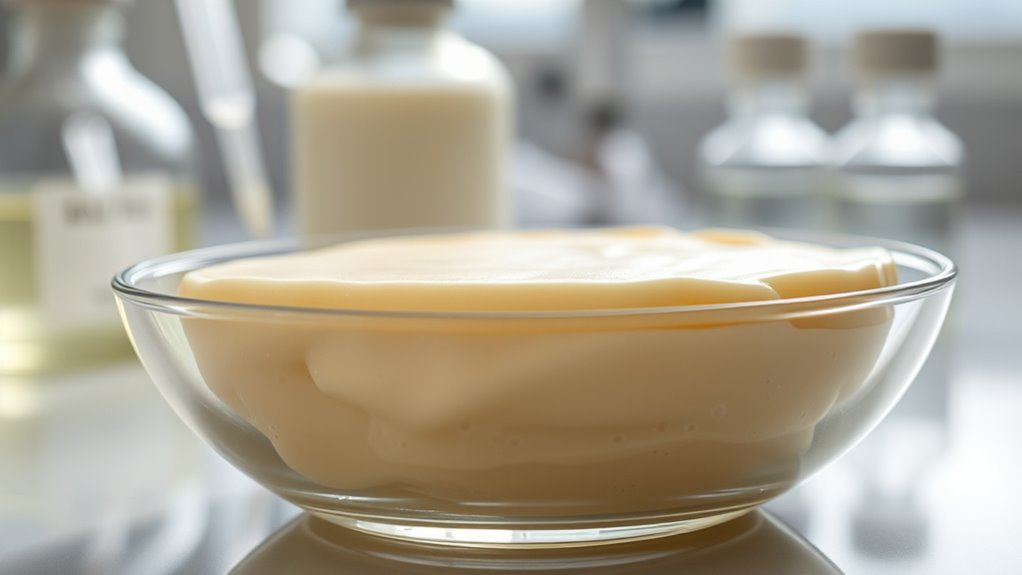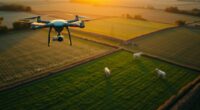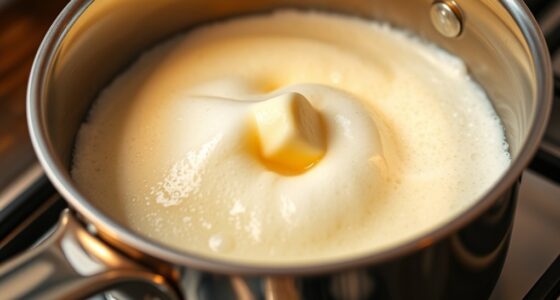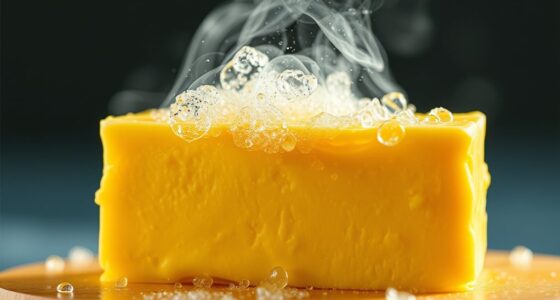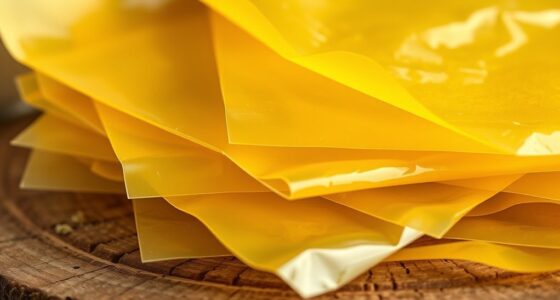Precision fermentation allows you to enjoy dairy-like butter proteins without involving cows. It uses genetically engineered microbes in bioreactors to produce fats and proteins that mimic traditional dairy, offering a sustainable, animal-free alternative. This process lowers environmental impact and reduces resource use while providing familiar taste and texture. If you want to discover how this innovative technology is reshaping the future of dairy, there’s plenty more to explore.
Key Takeaways
- Precision fermentation produces dairy-like butter proteins using genetically engineered microbes, eliminating the need for cow-based dairy farming.
- Controlled bioreactor processes ensure consistent, high-quality butter proteins with similar taste and texture to traditional butter.
- This technology significantly reduces environmental impacts, including land use, water consumption, and greenhouse gas emissions.
- Regulatory challenges and market acceptance are key factors influencing the adoption of fermentation-derived butter proteins.
- The industry aims to reshape dairy markets by offering sustainable, animal-free butter alternatives with scalable production methods.
Understanding Precision Fermentation and Its Role in Food Production

Precision fermentation is transforming how we produce food by harnessing microorganisms to create specific proteins and compounds. This process relies heavily on genetic engineering, where scientists modify microorganisms’ DNA to produce desired ingredients efficiently. Fermentation technology is the backbone of this approach, enabling these microbes to convert simple nutrients into complex proteins, such as those found in dairy products. Unlike traditional farming, precision fermentation allows for the production of high-quality, animal-free ingredients at a lower environmental cost. By precisely controlling fermentation conditions, you can generate consistent, sustainable outputs that meet consumer demands for plant-based and ethical food options. Additionally, Decor – Grace for Life Designs showcases how incorporating natural textures and handcrafted decor elements can enhance the presentation of innovative food products like dairy alternatives. Overall, this innovative use of genetic engineering and fermentation technology is revolutionizing food manufacturing, providing new avenues for dairy alternatives and other specialty ingredients.
How “Butter” Proteins Are Manufactured Using Biotechnology

Using biotechnology, manufacturers produce “butter” proteins by genetically engineering microorganisms to synthesize dairy-specific fats and proteins. This process begins with genetic engineering, where genes responsible for dairy protein production are inserted into microorganisms like yeast or bacteria. These modified microbes are then cultivated using bioreactor technology, which provides controlled conditions for ideal growth and protein expression. As the microorganisms grow, they produce targeted dairy proteins and fats that mimic traditional butter’s composition. Once fermentation is complete, the proteins are harvested, purified, and processed into a butter-like product. This method offers a sustainable, scalable way to produce dairy proteins without cows, relying on precise genetic modifications and advanced bioreactor systems to guarantee consistent quality and efficiency. High-quality production techniques ensure the final product closely resembles traditional dairy butter in both texture and flavor.
Comparing Traditional Dairy and Precision Fermentation-Based Alternatives

While traditional dairy farming relies on raising cows to produce milk and butter, precision fermentation offers a compelling alternative by creating dairy proteins and fats without animal agriculture. This shift impacts dairy sustainability by reducing land use, water consumption, and greenhouse gas emissions. It also addresses animal welfare concerns, eliminating the need for large-scale dairy operations that often involve stressful conditions for cows. Compared to conventional methods, fermentation-based alternatives can deliver the same nutritional benefits with a smaller environmental footprint. The development of beetroot recipes demonstrates how colorful, nutrient-rich foods can be incorporated into diets, highlighting the potential for plant-based and biotech alternatives to traditional dairy. While traditional dairy supports local economies and established supply chains, precision fermentation provides a scalable, ethical solution that can meet consumer demand for dairy products without the associated ethical and environmental costs. This comparison highlights the potential of biotech innovations to transform the dairy industry fundamentally.
Environmental Benefits of Producing Butter Proteins Without Cows
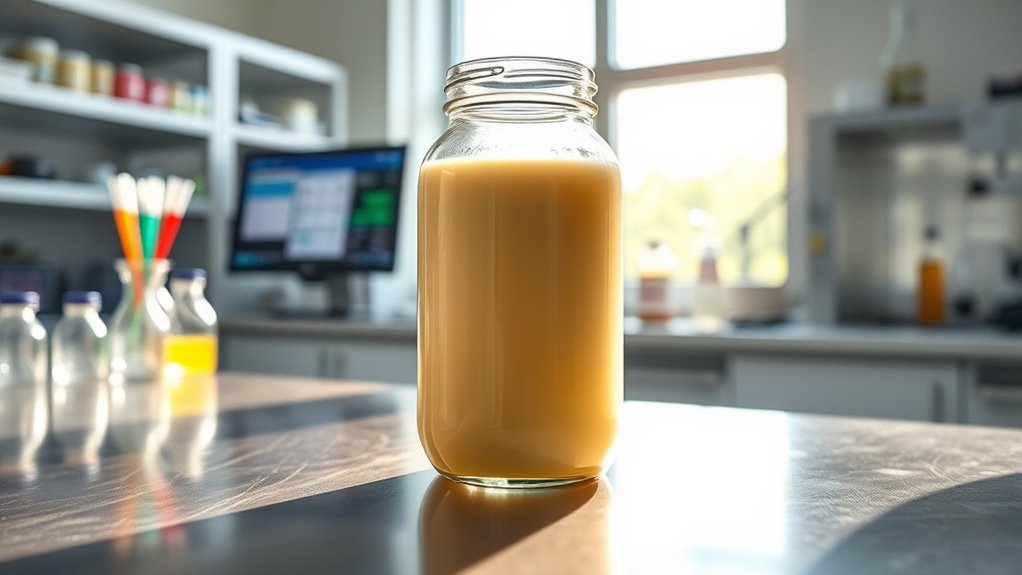
Producing butter proteins through precision fermentation considerably reduces environmental impacts compared to traditional cow-derived methods. By avoiding large-scale dairy farming, you lower the need for land, water, and feed, supporting more sustainable farming practices. This process also markedly cuts the carbon footprint associated with dairy production, as it requires less energy and produces fewer greenhouse gases. Without the emissions from cattle digestion and manure management, fermentation-based methods offer a cleaner alternative. Additionally, precision fermentation minimizes water pollution and waste runoff, helping preserve ecosystems. Implementing sustainable farming practices in production methods further enhances environmental benefits. Overall, this approach enables you to produce high-quality butter proteins while promoting environmental sustainability and reducing the strain on natural resources. It’s a smarter, more eco-friendly way to meet growing dairy demands without harming the planet.
The Taste, Texture, and Culinary Uses of Fermentation-Derived Butter
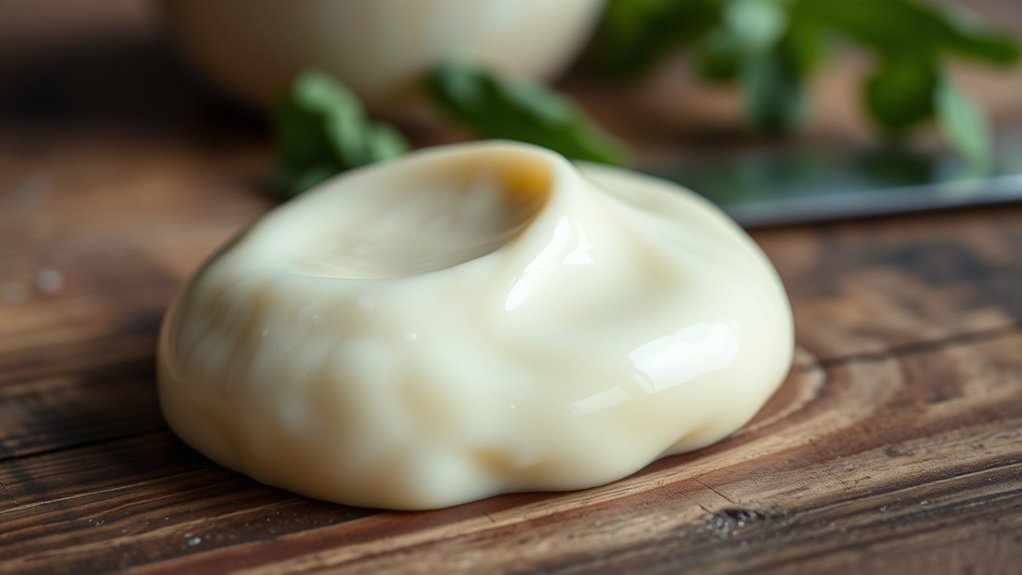
You’ll notice that fermentation-derived butter closely mimics the flavor profile of traditional butter, offering authentic richness and depth. Its texture is creamy and versatile, making it suitable for a variety of culinary uses. Whether baking, sautéing, or spreading, this innovative butter can elevate your dishes with familiar taste and performance. Additionally, its cultural significance can appeal to those seeking traditional flavors with a modern twist.
Flavor Profile and Authenticity
Fermentation-derived butter aims to replicate the rich, creamy flavor of traditional dairy butter, often boasting a slightly tangy undertone from the fermentation process. Achieving flavor authenticity is essential to create a convincing sensory experience that satisfies even discerning palates. The subtle tang adds depth, making it feel more genuine and natural. You’ll notice that high-quality fermentation butter closely mirrors the taste profile of its dairy counterpart, with nuanced buttery notes balanced by a gentle fermentation zing. This authenticity enhances your culinary experience, whether spread on bread or melted into dishes.
- Mimics traditional flavor nuances for a genuine taste
- Balances buttery richness with a slight tang
- Provides a rich sensory experience without dairy
- Ensures versatility across various culinary applications
Cooking and Baking Applications
Because its flavor closely mimics traditional butter, fermentation-derived butter works well in a variety of cooking and baking applications. Its rich, cultured dairy notes make it an excellent substitute in recipes that rely on butter’s unique taste and texture. You can use it for sautéing, spreading, or melting over vegetables and baked goods, just like conventional butter. Its smooth consistency allows it to blend seamlessly into doughs and batters, enhancing pastries, cookies, and muffins with authentic flavor. Since it’s vegan butter, it appeals to plant-based diets without sacrificing taste. Chefs and home bakers alike appreciate its versatility, especially when aiming for dairy-free or sustainable options. Incorporating leadership skills into product development and marketing strategies can also help promote its adoption in competitive markets. Overall, fermentation-derived butter offers a practical, flavorful alternative suited for a wide range of culinary creations.
Challenges and Opportunities in Scaling Up Precision Fermentation Dairy Products

Scaling up precision fermentation dairy products presents both significant opportunities and complex challenges. You’ll need robust scaling infrastructure to meet rising demand efficiently. Regulatory hurdles also pose obstacles, as new products must navigate evolving safety standards and approvals. Key challenges include maintaining product consistency, reducing production costs, and establishing supply chains. Opportunities lie in expanding market access and reducing environmental impact by replacing traditional dairy. To succeed, you must invest in advanced bioreactor technology and streamline processes. Collaborating with regulators early can help address approval issues faster. Market acceptance depends on transparent communication about safety and benefits. Additionally, leveraging AI tools can optimize production processes and improve quality control. Overall, balancing technological advancement with regulatory compliance will determine your ability to scale these innovative dairy alternatives successfully.
The Future Impact of Animal-Free Dairy Proteins on the Food Industry

Animal-free dairy proteins could reshape the food industry by challenging traditional dairy markets and prompting innovation. You might also see significant environmental benefits as these proteins reduce resource use and emissions. Additionally, advancements in well-being techniques such as sustainable practices can support the adoption of animal-free dairy options. However, market adoption hurdles could slow progress, requiring strategic efforts to overcome consumer skepticism and regulatory barriers.
Industry Disruption Potential
The rise of precision fermentation “butter” proteins has the potential to fundamentally reshape the dairy industry by offering a sustainable and cost-effective alternative to traditional animal-based products. This innovation leverages genetic engineering to produce dairy proteins without cows, disrupting existing supply chains. As this technology advances, you could see reduced reliance on livestock farming, leading to lower costs and increased product consistency. It also opens opportunities for local production, minimizing transportation and logistics challenges. Additionally, the growing trend of Hackathons fosters innovation and collaboration among researchers and industry leaders to accelerate development in this field. However, industry disruption may face resistance from traditional dairy producers and regulatory hurdles. The shift toward animal-free dairy proteins signals a move toward a more flexible, resilient food system with the power to change how dairy products are made and distributed.
- Reduced dependence on traditional supply chains
- Lower production costs and increased scalability
- Greater control over protein quality and safety
- Potential for regionalized manufacturing
Environmental Benefits Outlook
As precision fermentation “butter” proteins become more widespread, their environmental benefits could considerably transform the food industry. By reducing reliance on traditional dairy farming, they cut greenhouse gas emissions and minimize land and water use. Genetic engineering enables precise production, streamlining the supply chain and lowering resource waste. This shift can lead to a more resilient and sustainable industry. Additionally, glycolic acid products demonstrate how targeted chemical formulations can promote skin health and environmental sustainability through eco-friendly manufacturing processes.
Market Adoption Challenges
Although precision fermentation offers significant environmental benefits, widespread adoption faces several market hurdles. Regulatory hurdles create delays and uncertainties, as approval processes vary across regions and may slow product launches. Consumer acceptance remains a key challenge; many people are hesitant to trust animal-free proteins, especially without long-term safety data. Additionally, existing dairy industry players might resist change, fearing market disruption or loss of tradition. Price competitiveness is another concern, as production costs must decrease for these proteins to compete with traditional dairy. To succeed, you’ll need to address perceptions, navigate regulations, and demonstrate that animal-free dairy proteins are safe, sustainable, and delicious. Overcoming these barriers is essential for the future of dairy without cows.
Frequently Asked Questions
How Long Does It Take to Produce Fermentation-Derived Butter Proteins?
The production timeline for fermentation-derived butter proteins typically takes a few weeks. During the fermentation process, microorganisms produce the targeted proteins efficiently, but factors like fermentation conditions and scale can influence the timeline. You might expect the initial stages to take about one to two weeks, with additional time needed for purification and quality checks. Overall, this process is faster than traditional dairy farming and allows you to produce high-quality butter proteins sustainably.
Are Precision Fermentation Butter Proteins Allergen-Free?
You might think all butter proteins are allergen-free or risk-free, but that’s not always the case. Precision fermentation companies conduct thorough allergenicity assessments to identify potential allergens, ensuring safety. Labeling regulations also require clear disclosure if any allergens are present. So, while many products aim to be allergen-free, it’s essential to check labels and trust verified assessments for peace of mind in your dairy alternatives.
What Are the Costs Associated With Producing Biotech-Based Butter?
When you consider biotech-based butter production, the costs mainly depend on production scale and raw material costs. Larger scales can reduce per-unit expenses through efficiencies, but initial investments in bioreactors and infrastructure are significant. Raw materials like fermentation media also impact costs, though they can be optimized over time. Overall, while biotech butter may have higher upfront costs, scaling up production can make it more competitive with traditional dairy.
Can Fermentation-Based Butter Fully Replicate Traditional Dairy Butter?
Did you know that plant-based alternatives now make up about 10% of global dairy sales? When it comes to fermentation-based butter, it can closely mimic traditional dairy butter in taste and texture, but some nuances remain. While it offers environmental benefits like reduced greenhouse gases, fully replicating the complexity of traditional dairy butter is challenging. Still, advancements are narrowing that gap, making it a promising alternative for consumers seeking sustainable options.
How Will Regulation Impact the Commercialization of Precision Fermentation Dairy?
You’ll find that regulation plays a vital role in bringing fermentation-based dairy products to market. Regulatory hurdles can delay approval and increase costs, making commercialization more challenging. However, as consumer interest in plant-based and sustainable options grows, market acceptance is likely to improve. Managing these regulations effectively will be key to scaling production, gaining consumer trust, and ensuring widespread adoption of these innovative dairy alternatives.
Conclusion
As you explore precision fermentation, it’s fascinating to see how creating butter proteins without cows might just coincide with a more sustainable future. Imagine enjoying dairy delights, knowing they come from innovative biotech rather than traditional farming. This unexpected blend of science and nature could transform your culinary choices while reducing environmental impact. So, as these technologies develop, you might find yourself savoring familiar flavors with a surprising, eco-friendly twist—making the future of dairy both exciting and sustainable.
